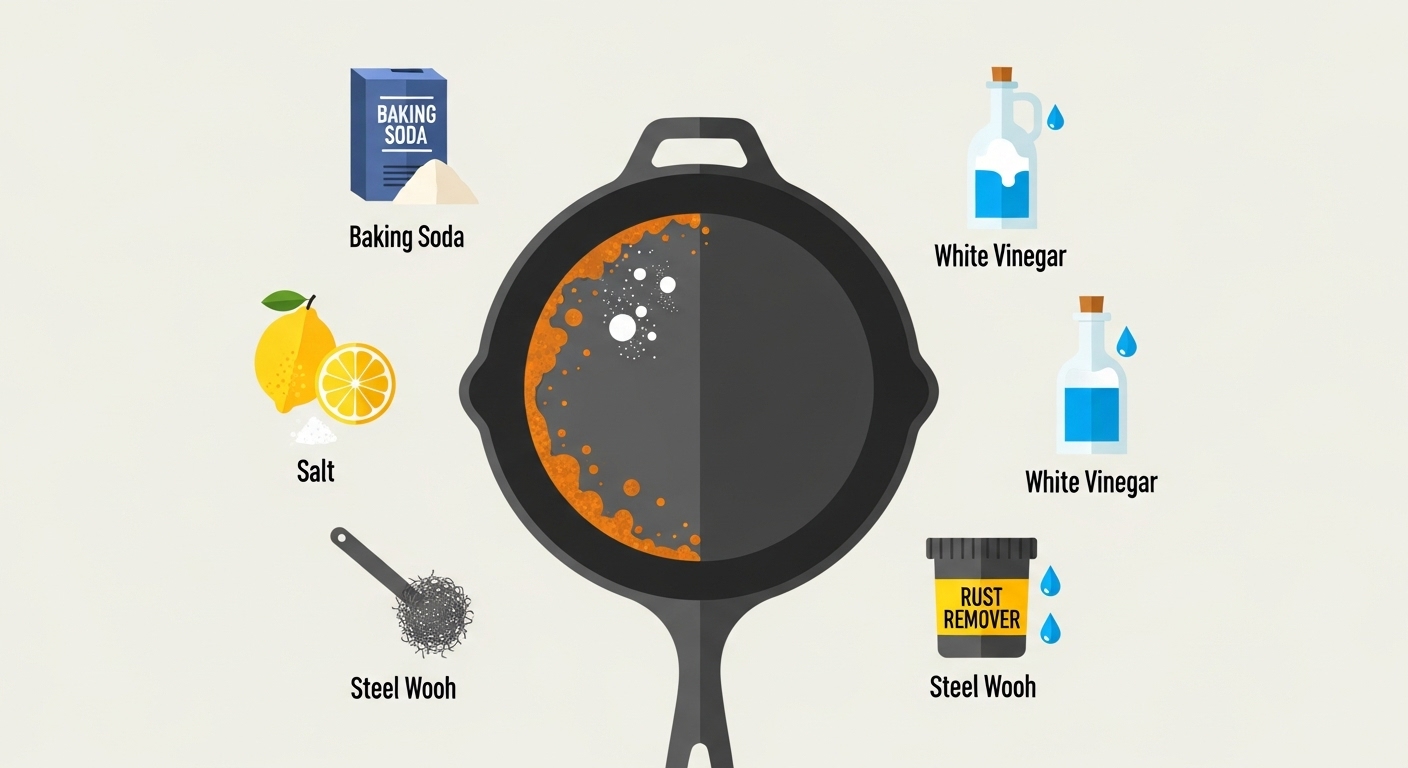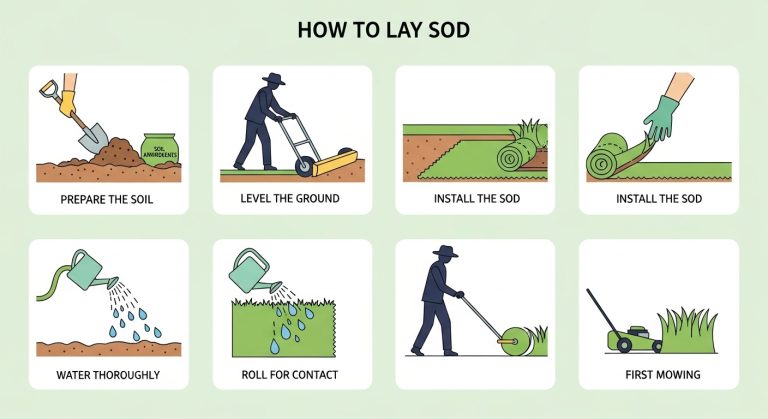How to Remove Rust from Cast Iron: A Complete Guide
Cast iron cookware has long held a beloved place in home kitchens, cherished for its exceptional heat retention, versatility, and durability. However, even the best cookware can suffer from rust over time, leading many cooks to ask how to remove rust from cast iron effectively. In this blog post, we’ll explore the causes of rust, how to identify it, and provide a step-by-step guide to rust removal, restoration, and maintenance tips to keep your cast iron in fantastic shape.

Understanding these factors emphasizes why prompt rust prevention and removal is essential for your cookware’s longevity and optimal cooking performance
Identifying Rust on Your Cast Iron
Identifying rust on your cast iron is the first step toward effective restoration. Look for these clear signs:
Observable Signs of Rust:
- Orange or reddish spots
- Flakes or dull surfaces
- Rough patches or powdery residues
Next, understand the distinction between surface rust and deeper corrosion:
- Surface Rust: Light rust confined to the top layer, easily removable with scrubbing.
- Deep Corrosion: This indicates pitting or more severe damage, sometimes suggesting professional intervention may be necessary.
Close inspection of your cookware before beginning any rust removal is crucial to assess the severity of the issue.
How to Remove Rust from Cast Iron
Materials Needed
Before diving into rust removal, gather the following materials:
- Steel Wool or Stiff Brush: For scrubbing away rust.
- Coarse Salt or Baking Soda: Used as mild abrasives.
- White Vinegar: Helpful for soaking stubborn rust.
- Mild Dish Soap: Optional, and only when necessary.
- Paper Towels and Clean Rags: For drying.
- Vegetable, Flaxseed, or Canola Oil: For re-seasoning after cleaning.
Step-by-Step Guide
Follow this detailed guide to successfully remove rust from your cast iron cookware:
- Scrub the Rusty Areas: Firmly scrub the affected areas with steel wool or a stiff brush. Use salt or baking soda as a mild abrasive; adding a small amount of water can help.
- Soak for Heavy Rust: If the rust is heavy, soak your pan in a mixture of equal parts white vinegar and water for up to one hour. Be cautious not to exceed this time, as vinegar can damage iron beyond repair.
- Scrub Again: After soaking, scrub the pan once more to remove the loosened rust.
- Rinse Thoroughly: Rinse the pan well with warm water.
- Dry Immediately: Dry thoroughly with paper towels. To ensure all moisture evaporates, heat the pan briefly on the stovetop.
- Inspect the Pan: After drying, inspect the pan. If any rust remains, repeat the soak and scrub process.
- Proceed to Seasoning: Once rust is completely removed, you can proceed to season your cast iron.
Safety Tip: Be sure to avoid inhaling rust dust. If the cookware is quite old and rusting heavily, check for deep pitting that may not be restorable.
Alternative Methods
Many home cooks prefer natural cleaners like salt and baking soda, which can be safe and effective for rust removal. While commercial rust removers do exist, exercise caution in your selection, ensuring they do not leave harmful residues on cookware surfaces.
Note: If you’re dealing with stubborn residues beyond rust, don’t miss our guide on how to get super glue off fingers for another quick household fix.
Restoring Cast Iron After Rust Removal
Re-seasoning Your Cast Iron
Once the rust is gone, re-seasoning is crucial to restore your cast iron’s non-stick surface and protect it against future rust. Here’s how:
- Coat the pan: Apply a thin layer of vegetable oil (or flaxseed/canola oil) over the clean, dry surface.
- Bake the pan: Place the pan upside down in a preheated oven at 450°F (230°C) for one hour.
- Cool in the oven: Allow the pan to cool inside the oven to complete the seasoning process.
This process not only reinforces the non-stick properties of your pan but also creates a rust barrier.
Maintaining the Non-Stick Surface
It’s vital to maintain that non-stick surface over time. Here are some tips:
- After each cleaning, apply a light coat of oil to preserve the seasoning and protect against moisture.
- Use routine cleaning methods that safeguard the seasoned surface—avoid harsh detergents unless rust removal is absolutely necessary.
- Regular use of your cast iron cookware helps build up seasoning over time.
Cleaning a Rusty Skillet Effectively
To clean a rusty skillet, follow these straightforward steps:
- Scrubbing: Use steel wool or coarse salt to scrub the rusty areas. Avoid soaking the skillet for prolonged periods to prevent further rusting.
- Dry Immediately: It’s essential to dry the skillet thoroughly right after cleaning to prevent new rust from forming.
- Re-season Promptly: After rust removal, season the skillet without delay to secure protection and restore its cooking surface.
Cast Iron Cleaning Tips
In this section, cast iron cleaning tips are invaluable for maintaining your cookware:
Daily Maintenance
- Clean your cast iron after every use with hot water and a stiff brush or sponge. Only use soap if absolutely necessary, as harsh detergents can strip seasoning.
- Dry thoroughly right after cleaning and apply a light coat of oil to prevent rusting.
Deep Cleaning Techniques
- For stuck-on food or minor rust, use coarse salt or baking soda as scrubs.
- Avoid soaking your cookware or using harsh detergents unless you’re addressing rust.
Storage Recommendations
- Store your cast iron in a dry environment. Placing paper towels between stacked pans can help absorb moisture.
- Avoid using plastic bags or airtight containers that can trap moisture, leading to rust.
Preventing Rust on Cast Iron Cookware
To keep your cast iron cookware rust-free, enforce these practices:
- Always Dry Thoroughly: Ensure your cookware is dried immediately after washing, using heat to eliminate any residual moisture.
- Regularly Reseason: Learn to reseason cookware by applying thin oil layers after cleaning.
- Store Correctly: Keep cast iron in a dry place, avoiding potential moisture traps.
These practices maintain seasoning and significantly reduce the chances of rust forming.
Common Mistakes to Avoid When Cleaning Cast Iron
Here are some common mistakes that can facilitate rust or damage:
- Soaking Cookware: Never leave cast iron soaking in water, as it encourages rust; this is a critical point to remember.
- Harsh Detergents: Don’t use aggressive materials or cleaning agents unless necessary for rust removal, as these strip away the seasoning.
- Skipping Reseasoning: Always reseason after rust removal or if soap was used to clean your pan.
By sidestepping these pitfalls, you can ensure that your cast iron retains its integrity and functionality.
FAQs – Frequently Asked Questions
Q: What is the safest way to clean rusty cast iron?
A: Use steel wool gently with mild abrasives like salt or baking soda, rinse, dry thoroughly, and re-season.
Q: Does removing rust also remove seasoning?
A: Yes, sometimes rust removal may strip some seasoning away, which is why re-seasoning afterward is crucial.
Q: Can I use commercial rust removers on cookware?
A: While possible, make sure to choose food-safe products and verify that they’re appropriate for cast iron surfaces.
Q: How often should I season cast iron?
A: It’s best to season after deep cleaning or if the pan appears dry or rusty.
Q: How do I know if my pan is too damaged to restore cast iron?
A: Look for deep pitting. If the surface is structurally compromised, it may not be safe to restore.
Conclusion
In conclusion, understanding how to remove rust from cast iron is essential knowledge for any home cook. By recognizing the signs of rust, employing safe and effective removal methods, and keeping up with routine maintenance, you can restore and preserve your cookware’s excellent properties. A well-cared-for cast iron skillet can last a lifetime, offering unmatched cooking experiences. We invite you to share your own rust removal and restoration experiences or ask any questions you have in the comments below!
Key Takeaways
- Understanding how to clean and maintain cast iron is essential for longevity.
- Immediate rust identification and removal can save your cookware from severe damage.
- Regular seasoning protects against rust and enhances the cooking surface.






